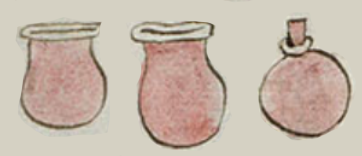patli (CST27)
This painting of the simplex glyph for the term patli (or pahtli, with the glottal stop, meaning medicine or pharmaceuticals) shows three bottles of “Castilian medicinal oil and many [other] Castilian things” that were purchased for this town from an apothecary in Mexico City with the name of Nieto. The containers are all light red bottles. Two have white-rimmed open mouths and one (much rounder) has a small mouth with a tan-colored cork in it.
Stephanie Wood
It is fascinating that this town, with its wealth from silk production, would send someone to purchase European medicines in Mexico City, when Oaxaca has an abundance of herbal remedies that are still in broad use in Oaxaca today. See below for some herbal remedies and other glyphic references to Nahua medicines. Incidentally, Kevin Terraciano discovered that the boticario (apothecary) who likely sold the goods shown in this glyph to someone from Texupan is mentioned in the records of the municipal council in Mexico City. He had the full name Rodrigo Nieto and was still active in January of 1565, some years after this mention here. For more on the Codex Sierra, see Kevin Terraciano’s study (2021), especially, p. 152, for the translation of the companion text for this image.
Stephanie Wood
1550–1564
Jeff Haskett-Wood
medicinas, aceites, boticarios, farmacias

pa(tli), medicine, https://nahuatl.wired-humanities.org/content/patli
medicina
Stephanie Wood
Códice Sierra-Texupan, plate 27, page dated 1559. Origin: Santa Catalina Texupan, Mixteca Alta, State of Oaxaca. Kevin Terraciano has published an outstanding study of this manuscript (Codex Sierra, 2021), and in his book he refers to alphabetic and “pictorial” writing, not hieroglyphic writing. We are still counting some of the imagery from this source as hieroglyphic writing, but we are also including examples of “iconography” where the images verge on European style illustrations or scenes showing activities. We have this iconography category so that such images can be fruitfully compared with hieroglyphs. Hieroglyphic writing was evolving as a result of the influence of European illustrations, and even alphabetic writing impacted it.
https://bidilaf.buap.mx/objeto.xql?id=48281&busqueda=Texupan&action=search
The Biblioteca Digital Lafragua of the Biblioteca Histórica José María Lafragua in Puebla, Mexico, publishes this Códice Sierra-Texupan, 1550–1564 (62pp., 30.7 x 21.8 cm.), referring to it as being in the “Public Domain.” This image is published here under a Creative Commons license, asking that you cite the Biblioteca Digital Lafragua and this Visual Lexicon of Aztec Hieroglyphs.






